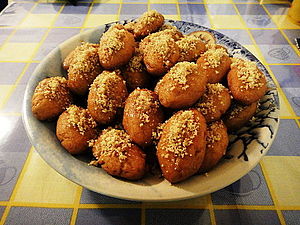 | |
| Course | Dessert |
|---|---|
| Place of origin | Greece |
| Main ingredients | Semolina, olive oil and honey |

The melomakarono (Greek: μελομακάρονο plural: μελομακάρονα, melomakarona) is an egg-shaped Greek dessert made mainly from flour, olive oil, and honey. Along with the kourabies, it is a traditional dessert prepared primarily during the Christmas holiday season. They are also known as finikia.
Historically, melomakarona are thought to be derived from the ancient and medieval makaria, which were eaten during funerals. Gradual changes in the recipe and the addition of dipping them in honey led to melomakarona which etymologically is derived from the Greek word for honey "meli" and "makaria".
Typical ingredients of the melomakarono are flour or semolina, sugar, orange zest and/or fresh juice, cognac (or similar beverage), cinnamon, crushed or ground clove and olive oil. During rolling they are often filled with ground walnuts. Immediately after baking, they are immersed for a few seconds in cold syrup made of honey and sugar dissolved in water. Finally, they are decorated with ground, as well as bigger pieces of walnut. Dark chocolate-covered melomakarona are also a more recent variation of the traditional recipe.
See also
References
- "Melomakarona - Honey Cookies with Walnuts". About.com. Archived from the original on 2011-12-27. Retrieved 2011-12-24.
- "Greek Melomakarona Are Tasty Walnut Cookies Sweetened With Honey". The Spruce Eats.
- "Finikia". Allrecipes.com. Archived from the original on 2010-12-13. Retrieved 2010-12-21.
- "The Etymological Roots of Melomakarona and Kourambiedes". greece.greekreporter.com. 24 December 2015. Retrieved 17 April 2020.
- Yagkou, Varvara. "Μελομακάρονα γεμιστά". foodmuseum.cs.ucy.ac.cy (in Greek). Cyprus Food Virtual Museum. Retrieved 27 November 2015.
- "Μελομακάρονα γεμιστά". mysteriousgreece.com. 15 December 2015. Retrieved 17 April 2020.